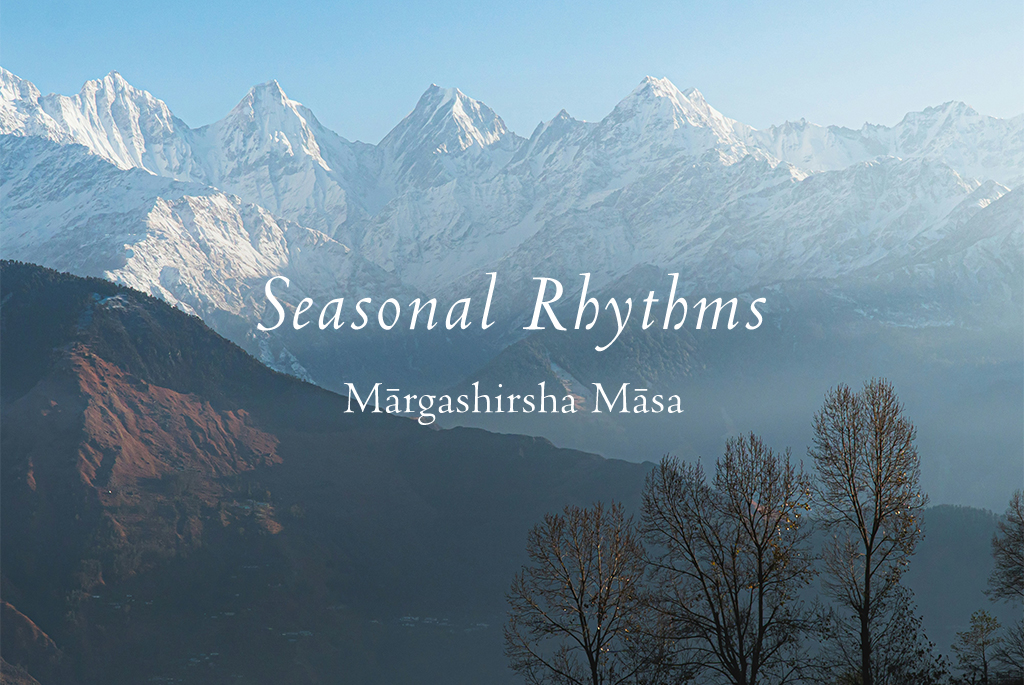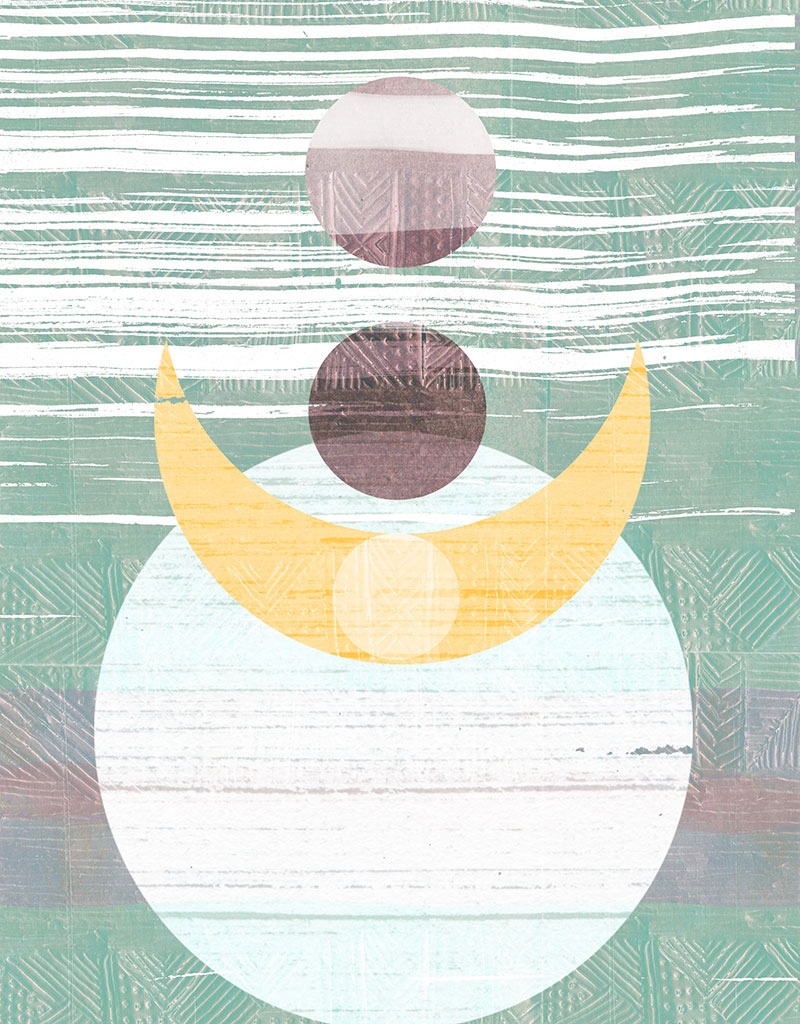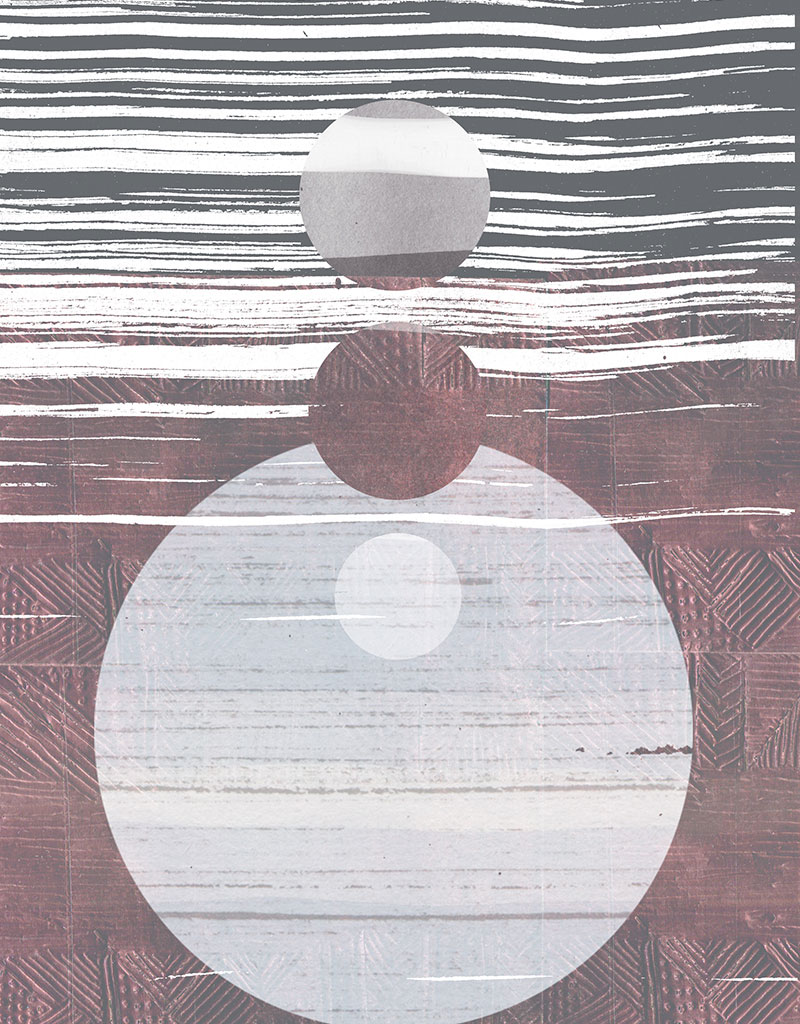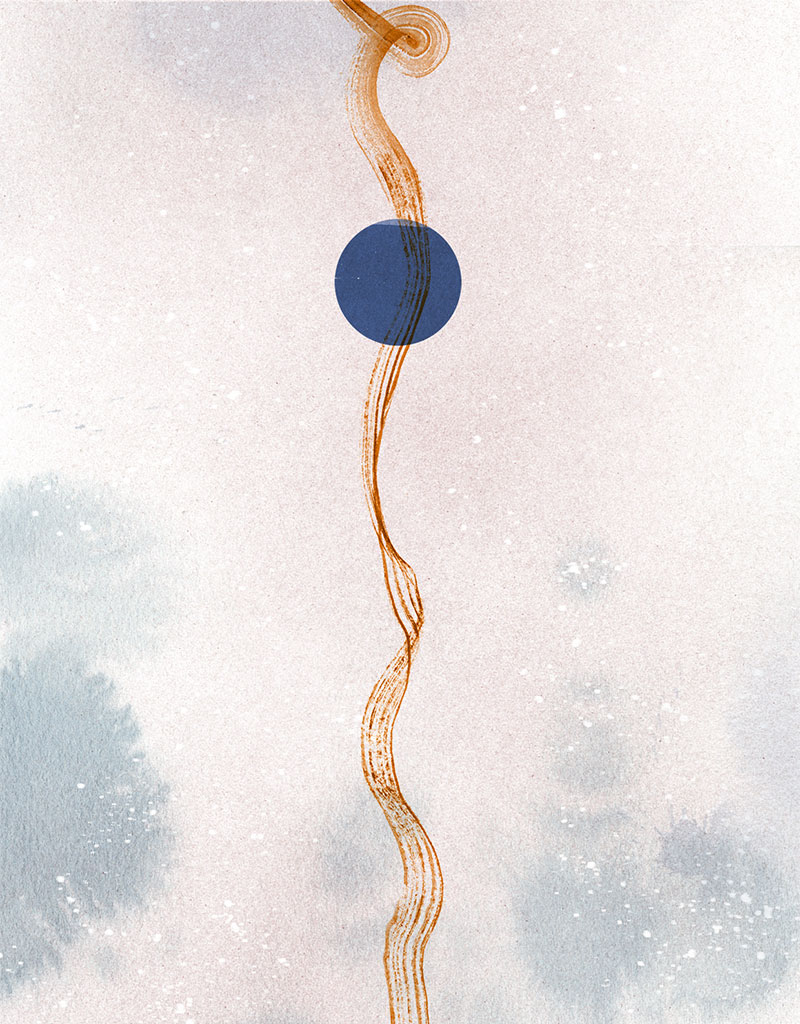Nilakshi Sharma

Not with sandal paste, but tints
Red-brown of the saffron,
Do elegant and full-breasted women
Now their bosoms ornament,
And with jasmine garlands
That gleam like frost and the moon.
Ritusamharam by Kalidasa
Mārgashirsha māsa brings with it cold weather and marks the onset of Hemanta Rtu, the first of the two rtus (seasons) that make up the four-month-long winter season in the subcontinent. Hemanta rtu is a season of increasing intensity – day by day the cold increases and the light and warmth of the Sun decreases. It is in this season that we witness the Winter Solstice, the shortest day and longest night of the year.
Thus, Mārgashirsha month signals the time to turn indoors and inwards; in the words of Kalidasa, “It is a time that people pass, with a fire, or in bright sunlight, with heavy garments for young ladies, and windows kept shut in the house.”
As winters begin to settle over the land, the gaiety and colours of Sharad rtu give way to a quietening of the world. The bright blooms of Sharad give way to the softer, muted colour palette of winter. The blue skies slowly start changing to leaden greyness. The bright sunshine gives way to diffused light. The water bodies and slowly even the earth itself starts becoming shrouded in fog and frost sparkles in the pale winter sunlight in the mornings. All of these external changes in the environment have a profound impact on our bodies and minds. And thus, the seasonal practices for Hemanta rtu are the ones we should turn to for a better synchronisation with nature.
Winter Practices
“Winter is a season of recovery and preparation.” Paul Theroux
In Ayurvedic terms the Vata-dominant characteristics of Sharad rtu start giving way to Kapha-dominant characteristics of Hemanta rtu. But while winter is the season of Kapha dosha dominance there continues to be strong Vata dosha presence as well. Especially in the first month of the season. The winter season is characterised by cold weather, heaviness and general dryness. But winter is also the season of chilly, cold winds and sudden temperature drops. For many people the winter season also equals a rise in mucous related illnesses.
At its best, winter can translate to being a time of strength and stability. Our digestive fires are actually the strongest in the winters. But without appropriate care winters can also become a time of stagnation, weight gain and constant problems of congestion, cold and cough. Some recommended Ayurvedic practices can really help us enjoy winters as a time of stability and strength.
Abhyanga: The centuries-old Ayurvedic ritual of self-massage with warm oil is one that cannot be highly recommended enough. It nourishes your body, rejuvenates your skin and mind, enhances blood flow, can reduce inflammation, can help decrease stress, calm your nervous system and can promote better sleep.
Use gently warm oil – Sesame, Mustard or best of all, an Ayurvedic herbal body oil. Massage the body in gentle long strokes. Pay special attention to joints, using soft circular strokes. Also remember to put some oil into your navel. Then let the oil soak into the body for 15 to 20 minutes before bathing with warm but not too hot water. Ideally use an ubtan – a traditional mix of powdered grains and clays, to take away excess oil instead of soap or bodywash.
Try it as a daily practice for a week and see the difference. Improvement in skin elasticity and texture is yet another side bonus of this deeply meditative selfcare ritual.
Nourishing Foods: Winter is the time to eat nuts and seeds, whole grains and root vegetables along with dark leafy green vegetables. Sesame is particularly good. Fats such as Ghee are also vital for wellbeing in winters. Remember to include seasonal fruits in your diet as well. According to Ayurveda Sweet, Sour and Salty tastes should be predominant in the foods that we consume in winters.
Warming Spices: The use of warming spices such as Cinnamon, Turmeric, Cloves and Black Pepper is also highly recommended during the winter season. If you do experience excess mucous build-up or congestion Cinnamon, Black Pepper, Honey, Cardamom and Ginger can be particularly helpful. A simple way to enjoy the benefits of these spices and herbs is to make tisanes – just steep a small quantity of the desired herb or spice in half a cup of boiling hot water and drink. Note: Honey should never be heated or steeped in hot water according to Ayurvedic principles.
One traditional winter remedy is to mix an equal measure of powdered Cinnamon & dried Ginger (a pinch of each or ¼ teaspoon each) with a teaspoon of Honey to help soothe your respiratory tract and to help clear mucus.
Exercise: Winter is the season when movement and exercise should be a regular part of our daily routine. Because otherwise the Kapha dominance in the season can also lead to stagnation and sluggishness. Along with improving our blood circulation, digestion and fitness, exercise in winters is also a very good way of helping us cope with the occasional melancholy that the winter season lends itself to for so many of us.
Turning Inwards
Dakshināyana, the second half of the solar year is seen as the feminine time – when the Goddess is honoured and her energy - which nurtures, nourishes and creates, is predominant. Thus, the months that come in the time of Dakshināyana have traditionally been seen as the time for practices that nourish and build strength in the body and soul. This emphasis on personal practices deepens with the onset of Mārgashirsha, when the increasing stillness and solitude of the season seems to be encouraging us to turn our focus inwards with meditation routines and meditative practices. The quieter, heavier energy of the season and the month subtly encourages practices of silence, reflection and inward focus; helping you in deepening them if you already have them and encouraging you to start them if you don’t.
There is a very wide range of meditation practices available. We all need to find the ones that appeal to us and work with our lifestyle and our needs. But for those who are still searching and experimenting here are some practices that we are once again sharing in the hope that they might help some of our readers.
There is a very wide range of meditation practices available. We all need to find the ones that appeal to us and work with our lifestyle and our needs. But for those who are still searching and experimenting here are some practices that we are once again sharing in the hope that they might help some of our readers.
Mantra Meditation: One of the oldest and most traditional of Vedic practices is the chanting of Sanskrit mantras. It is also an ideal meditation practice for beginners. With its emphasis on the repetitive chanting of a given mantra, it gently lays the foundation for a dedicated meditation practice. When we sit and chant our mantra daily, over a course of time we gently teach our body and mind to learn to ignore the distractions and reach towards a place of stillness. A mantra practice can be as simple or ritualistic and elaborate as you wish. There is a vast repository of Sanskrit mantras to choose from – each mantra is aligned with a deity or a certain kind of energy, see which one resonates with you and start with that. As your practice deepens, you will be the best judge of whether you need another mantra or to continue with the one you started with.
Sacral Chakra Meditation: In the Vedic worldview there are seven Chakras or energy centres in our bodies: Muladhara – Root chakra, Svadhisthana- Sacral or Pelvic chakra, Manipura – Navel chakra, Anahata – Heart chakra, Vishuddha – Throat chakra, Ajna – Third Eye chakra and Sahastrahara – Crown chakra. They are thought to be key points that impact us physically, emotionally and spiritually. Each Chakra has its own colour, sound, iconography and mantra. The Chakras are also deeply linked to the energy of the five elements. This in turn links them to both – the three Ayurvedic doshas in our body as well as the seasons and their energy. When winter comes it is a good time to focus more on meditation centred around the Sacral or Pelvic chakra.
The element of Sacral chakra is water, upon which the season has a palpable impact – it becomes cold and freezes into snow. It is the water element that gives us fluidity and the ability to adapt and accept – in our body, mind and emotions. The stiffness that we can often feel in our bodies in winter can also be seen as the freezing of the water in this season. Meditation practices centred around the Sacral chakra help us keep our minds, bodies and emotions fluid and flowing instead of becoming stiff and stagnant. A physical sign that we need to work on the energy of our Sacral chakra is the tightness in our lower back and hips. Along with the meditation practices that focus on the energy of the Pelvic chakra, Yoga postures that help open up our hips, such as the butterfly posture (Bhadrasana), are also highly recommended.
Tratak Meditation: Again, this is a traditional meditation practice that is also one of the six practices or Shat Kriyas of cleansing. Loosely translated as Flame Gazing, Tratak is a meditation practice that involves gazing at a steady flame – ideally a diya (earthen lamp) filled with Ghee (clarified butter) and a handmade wick of cotton. Ensure that the lit diya is placed at eye level height and that there are no air drafts in the room. The steadier the flame, the better it is. It is ideal to learn the practice of Tratak meditation from a Yoga teacher. Among the benefits that nearly all forms of meditation bestow on the practitioner, Tratak is also thought to be very beneficial for the eyes and eyesight.
Winter’s Appeal
After the hustle and bustle, the colour and delight, the fragrance and celebrations of the festivals of Sharad rtu, the winter season is a much needed slowing down. A time of peace and quiet when we are meant to focus on rebuilding our strength; nurturing the practices the nourish our body and mind and deepening our rituals of selfcare. Because winter is the time of planting the seeds that will burst forth into a new cycle of seasons when spring arrives.
Winter is the time for hearty meals, for restful evenings filled with the warmth of fire and the company of family and friends. Winter is the time of long nights and restful sleep. And of going within and creating the practices and rituals for the self that can help us better our physical strength and deepen our mental and emotional resilience. Winter is the season of quiet peace and of beauty in silence.
May you all have a winter filled with warmth and peace.





